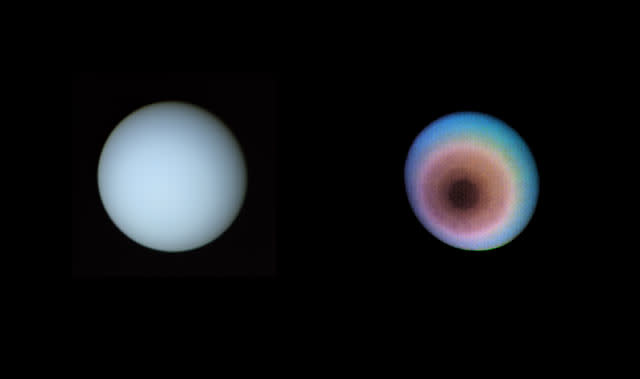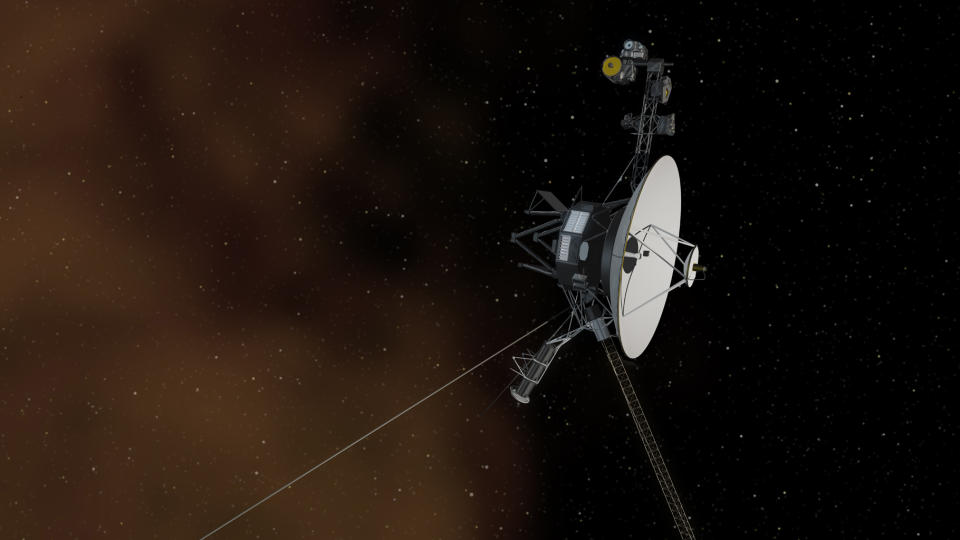Scientists may have solved a long-standing mystery surrounding the ice giant Uranus and its faint radiation belts. It’s possible that the belts’ faintness is related to the planet’s oddly tilted and lopsided magnetic field, which could be causing “traffic jams” for particles racing across the world.
The mystery dates back to Voyager 2’s visit to Uranus in January 1986, long before the probe left the solar system in 2018. The spacecraft discovered that Uranus’ magnetic field is asymmetric, tilted about 60 degrees from its rotational axis. In addition, Voyager 2 found that Uranus’ radiation belts, made up of particles trapped by this magnetic field, are about 100 times fainter than predicted.
The new research, based on simulations using Voyager 2 data, suggests that these two strange aspects of the ice giant are related.
“It has a magnetic field unlike anything else in the solar system. Most planets have strong intrinsic magnetic fields, like Earth, Jupiter, and Saturn. They have a very ‘traditional’ magnetic field shape, known as a dipole,” lead author Matthew Acevski told Space.com. “This is the same magnetic field shape you would expect from your everyday bar magnet. Uranus doesn’t have that; Uranus’ field is very asymmetric — and it’s getting closer and closer to the surface of the planets.”
Related: Uranus and Neptune are actually similar shades of blue, as shown in images of ‘true’ colors
Acevski explained that this research shows how Uranus’s magnetic asymmetry distorts the structure of the planet’s proton radiation belts, especially near the region where Voyager 2 passed.
“My hypothesis was that the magnetic asymmetry warped the proton radiation belts, creating regions around the planet where the radiation belts were more compressed,” Acevski said, “and therefore of higher intensity; other regions where they were more spread out led to lower intensity.
“If Voyager 2 flew through a region where the radiation belts were farther apart, that could explain the observations of fainter proton radiation belts than expected.”
An anomaly in the solar system
The coldest planet in the solar system and the seventh planet from the sun, Uranus is an oddball among the other worlds in our solar system. The ice giant rolls around like a cosmic ball, tilted in one direction at a 97-degree angle to the plane of its orbit. That means that when it rotates, it does so slightly “sideways.” It is the only planet in the solar system to do this.
The tilt, thought to be the result of a collision with an Earth-sized object in the distant past, gives Uranus the most extreme seasons in the solar system, with a winter that lasts 21 years. Uranus completes an orbit every 84 Earth years and is also one of only two planets in the solar system (the other being Venus) that orbits the sun in the opposite direction to all the other planets.
Uranus is about four times wider than Earth and is about 19 times farther from the sun than our planet, and is surrounded by 13 faint rings and at least 28 moons. Uranus also has auroras, similar to Earth’s Northern and Southern Lights, but because of the planet’s tilted magnetic field, they do not appear over the poles as they do over our planet, Jupiter, and even Saturn.
Like all planets with magnetic fields, charged particles are trapped around Uranus, creating radiation belts. Why these radiation belts appear so faint, however, has been a mystery for the past fifty years.

The team’s simulation abandoned the idea that Uranus’ magnetic field acts like a dipole and used a more complex quadrupole magnetic field to reproduce its skewed nature.
This showed that particles accelerate and decelerate as they pass through regions of different field strengths. The changes in the particles’ speed cause them to clump together in some regions and become more spread out in others. This effect only occurs when a single, complex quadrupole magnetic field is included in the simulation, and so it had never been seen before.
“We found that Uranus’ magnetic asymmetry can result in regions around the planet where the protons drift more slowly and are more compressed, and other regions where they drift more quickly and are more spread out,” Acevski said. “This is analogous to how traffic jams form on a ring road. When cars drive slower, there is more traffic; when cars drive faster, there is more traffic.”
Acevski and colleagues suspect that when Voyager 2 visited Uranus, it flew through a faint region in the ice giant’s radiation belt.
“We projected Voyager 2’s trajectory onto this profile and found that the spacecraft was indeed flying through a region of ‘fast drift,’ which would mean it should have observed a lower than normal proton radiation belt intensity,” Acevski said. “It is important to note that our particle simulations show that this result explains a maximum variation of about 20% of the proton intensity around the planet.”
That means the team’s model can’t fully explain the 100 times lower intensity observed by Voyager 2.
“It’s possible that whatever primary effect was causing these much weaker proton radiation belts could have been amplified by this effect we found,” Acevski continued. “We were very surprised by the results. It’s amazing to see how much influence magnetic asymmetry can have on the structure of the radiation belt. This was not known before.”


Acevski pointed out that the results he and the team obtained could help inform future space missions to Uranus. So far, Voyager 2 is the only spacecraft to visit the ice giant. This means that direct data about the world is extremely limited.
NASA plans to launch a mission to Uranus as early as 2030. Such a mission could help to experimentally verify the conclusion of this simulation.
“What we need to verify these simulations is a flagship spacecraft mission to Uranus to get new, in situ measurements of the planet over the course of several years instead of just a few hours like Voyager 2 did,” Acevski said. “A new mission could also allow us to discover new physics that we couldn’t even predict with simulations.
“Because this is a planet with a magnetic field that we’ve never seen before, it’s quite possible that completely new phenomena will be discovered, which would broaden our knowledge of planetary science.”
Related Stories:
— In the search for extraterrestrial life, scientists are looking for Earth-Jupiter pairs outside the solar system
— Infrared aurora on Uranus confirmed for the first time
— James Webb Space Telescope discovers jet stream on Jupiter stronger than a Category 5 hurricane
Acevski is certainly not done with this strange world in the solar system. The ice giant is a special fascination for the researcher.
“Uranus presents a unique challenge to science, one that I am very happy to take on. It is truly fascinating how much you can discover with so little data, and we are literally just getting started,” Acevski concluded. “At the moment, there are not many people studying the icy giant planets, Uranus and Neptune, despite the fact that they exhibit such strange features, particularly in their magnetic fields, and so drawing attention to the strange phenomena that may be occurring there is, for me, a very exciting prospect.”
The team’s research was published in June in the journal Geophysical Research Letters.